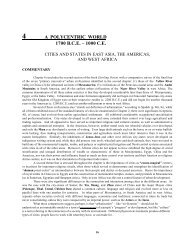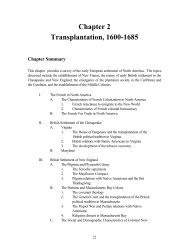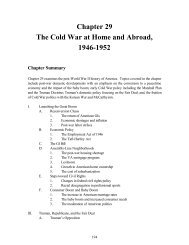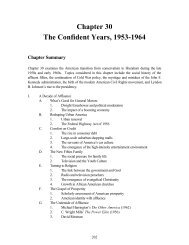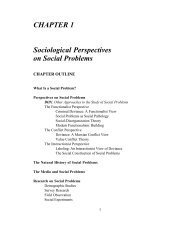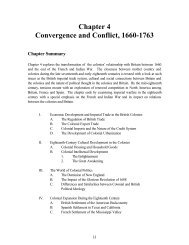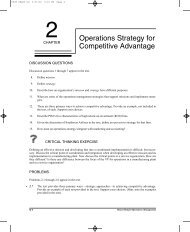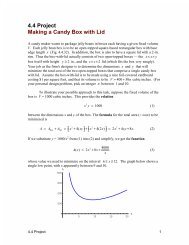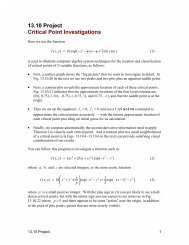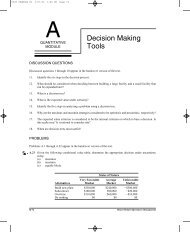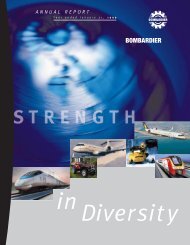Merchandising Operations and the Accounting Cycle - Pearson
Merchandising Operations and the Accounting Cycle - Pearson
Merchandising Operations and the Accounting Cycle - Pearson
You also want an ePaper? Increase the reach of your titles
YUMPU automatically turns print PDFs into web optimized ePapers that Google loves.
Journal<br />
Adjusting Entries<br />
a. Dec. 31 Interest receivable ................................................ 400<br />
Interest revenue .............................................. 400<br />
b. Dec. 31 Supplies expense ($650 – $100) .......................... 550<br />
Supplies............................................................ 550<br />
c. Dec. 31 Insurance expense................................................ 1,000<br />
Prepaid insurance ........................................... 1,000<br />
d. Dec. 31 Amortization expense—furniture ..................... 600<br />
Accumulated amortization—furniture........ 600<br />
e. Dec. 31 Unearned sales revenue ...................................... 1,300<br />
Sales revenue................................................... 1,300<br />
f. Dec. 31 Wages expense...................................................... 400<br />
Wages payable................................................. 400<br />
g. Dec. 31 Interest expense.................................................... 200<br />
Interest payable............................................... 200<br />
Closing Entries<br />
1. Dec. 31 Sales revenue .................................................... 169,300<br />
Interest revenue ................................................ 1,000<br />
Income summary ........................................ 170,300<br />
2. Dec. 31 Cost of goods sold ............................................ 135,200<br />
Inventory (beginning balance) .................. 38,600<br />
Purchases...................................................... 91,400<br />
Freight in ...................................................... 5,200<br />
3. Dec. 31 Inventory (ending balance)............................. 40,200<br />
Purchase discounts........................................... 3,000<br />
Purchase returns <strong>and</strong> allowances................... 1,200<br />
Cost of goods sold....................................... 44,400<br />
4. Dec. 31 Income summary.............................................. 116,450<br />
Sales discounts.................................................. 1,400<br />
Sales returns <strong>and</strong> allowances.......................... 2,000<br />
Cost of goods sold ($135,200 – $44,400) ........ 90,800<br />
Wages expense .................................................. 10,200<br />
Rent expense ..................................................... 8,400<br />
Amortization expense—furniture.................. 600<br />
Insurance expense ............................................ 1,000<br />
Supplies expense .............................................. 550<br />
Interest expense ................................................ 1,500<br />
5. Dec. 31 Income summary ($170,300 – $116,450) ........ 53,850<br />
Retained earnings........................................ 53,850<br />
6. Dec. 31 Retained earnings............................................. 54,100<br />
Dividends..................................................... 54,100<br />
Closing entry 4 <strong>the</strong>n closes <strong>the</strong> Sales contra accounts <strong>and</strong> <strong>the</strong> temporary Cost of<br />
Goods Sold account along with <strong>the</strong> o<strong>the</strong>r expense accounts into Income Summary.<br />
Closing entries 5 <strong>and</strong> 6 complete <strong>the</strong> closing process. All data for <strong>the</strong> closing entries<br />
are taken from <strong>the</strong> income statement columns of <strong>the</strong> work sheet. (Note that<br />
some companies close <strong>the</strong> accounts in closing entries 2 <strong>and</strong> 3 into <strong>the</strong> Income<br />
Summary account, instead of <strong>the</strong> temporary Cost of Goods Sold account. This has<br />
<strong>the</strong> same result overall. However, as mentioned above, Inventory <strong>and</strong> Cost of Goods<br />
Sold have <strong>the</strong>ir correct account balances before being closed to <strong>the</strong> Income summary<br />
account if <strong>the</strong>y are closed to <strong>the</strong> temporary Cost of Goods Sold account first.)<br />
Study Exhibits 5S-5, 5S-6, <strong>and</strong> 5S-7 carefully because <strong>the</strong>y illustrate <strong>the</strong> entire<br />
end-of-period process that leads to <strong>the</strong> financial statements. As you progress through<br />
this book, you may want to refer to <strong>the</strong>se exhibits to refresh your underst<strong>and</strong>ing<br />
of <strong>the</strong> adjusting <strong>and</strong> closing process for a merch<strong>and</strong>ising business.<br />
EXHIBIT 5S-7<br />
Adjusting <strong>and</strong> Closing Entries<br />
Chapter Five <strong>Merch<strong>and</strong>ising</strong> <strong>Operations</strong> <strong>and</strong> <strong>the</strong> <strong>Accounting</strong> <strong>Cycle</strong> 287



